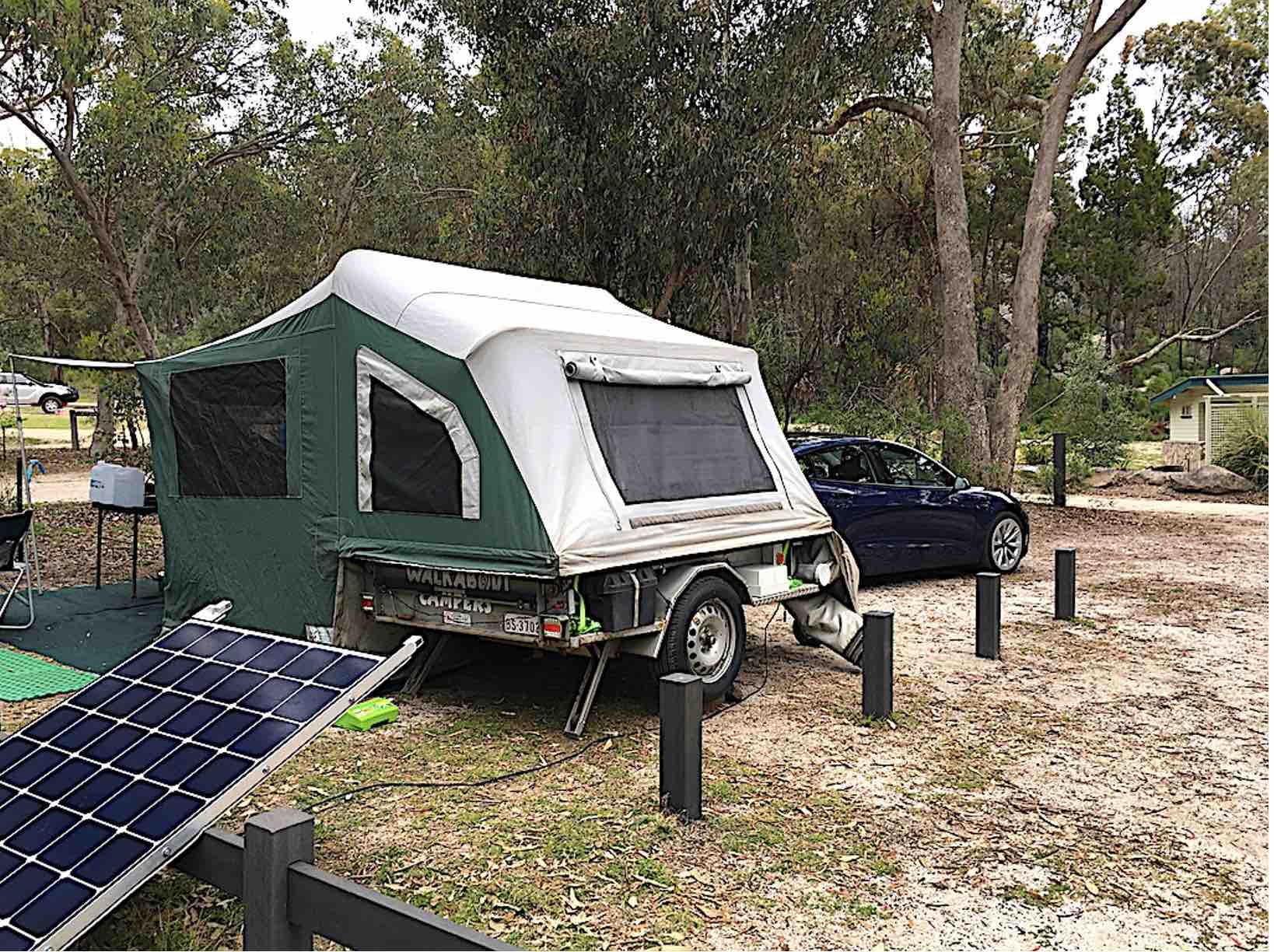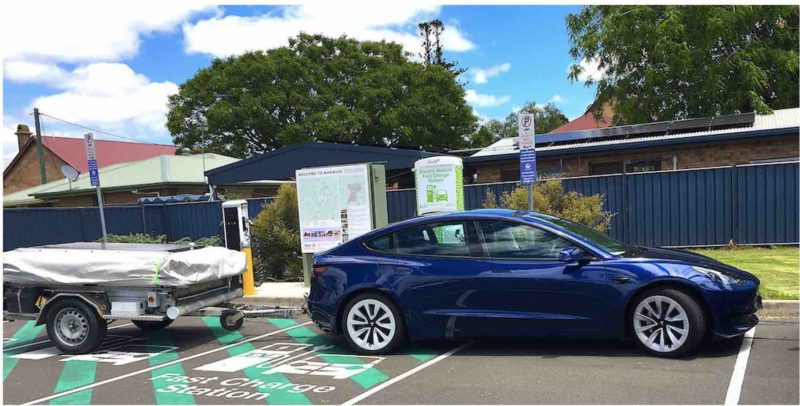Introduction & Purpose
With more electric vehicles coming to market certified for towing, there is understandably increasing curiosity about their real-world abilities in this regard.
Despite a deluge of misinformation, some of it intentional, early adopters like Luke Smith, Bryce Gaton, Peter Campbell, and Tim Hunt, have all contributed to building a comprehensive body of knowledge around the many variables related to towing with an electric vehicle.
The purpose of this article is to simply contribute a little more to this knowledge base from our own experiences.
Context
We use our Tesla Model 3 Dual Motor to tow our well-used, 20-year-old camper trailer, named ‘Slo-Mo” in reference to the fact that it is always unwilling to move, and has to be dragged into the future.
The trailer weighs in at 460kg, fully loaded with our camping gear, ancillary battery and 360W solar panel, but with an empty 60L water tank. A full water tank puts the weight at 520kg.
As a baseline the car’s overall efficiency after more than 10,000kms travelled to date is a sound 15.5kWh/100km, but towing the trailer clearly cuts into this efficiency which is the subject of this article.
Experiences
Our first towing experience was from our Brisbane northside residence to the Caboolture public weigh bridge, a round trip of 80km, largely at 100km/h.
With insignificant changes in elevation, ideal temperature of 25 degrees and negligible wind we got a brilliant 18.4kWh/100km, boding well for our plans to tour many parts of Australia, post Covid lock downs.
Next, we took a test run to Toowoomba and back, a round distance of 274km, mostly at 100km/h and to an elevation of 690m. This time we managed an efficiency of 19.6kWh/100km. Still very satisfying and better than many larger EVs can manage without towing.
Finally, a trip to one of our ‘favourite camping spots’, Girraween National Park south of Stanthorpe, for a 4 day get away. It’s 260km from our Brisbane residence and because of the various elevations along the way I will report on each section of the journey.
Starting from home with 90% SOC (state of charge), the first stage took us 166km to the Direct Current Fast Charger (DCFC) at Warwick, where we added 35kWh of zero cost, zero emissions electrons thanks to the support of the University of Queensland (UQ).
UQ have a number of free public DCFC and it produces all its own electricity partly from its large solar farm just outside Warwick
Our efficiency was 20.7kWh/100km which included the climb up Cunningham’s Gap with its speed limit of 70km/h along the steepest inclines.
We left Warwick after an hour with a new 90% SOC for the second section of 97km along the New England Highway to our destination. This leg saw a big fall in our efficiency, with elevation increases up to Dalveen at nearly 900m.
Notably the first 30km of this leg from Warwick, included long high-speed inclines that saw our efficiency at an abysmal 31kWh/100km, but by the time we arrived at Girraween overall efficiency for this 97km leg had averaged out at 24.7kWh/100km and we were left with a 52% SOC.
Four days later, and after taking some short trips around the locality without the trailer, we hitched up, zeroed the trip meter, and departed Girraween.
Again, we took the opportunity for a short DCFC at Warwick but only to 70% SOC this time, returning us home with a good buffer and an efficiency of 20.4kWh/100km for the entire 275km home trip.
| Brisbane to Warwick | 166 km | 20.7kWh/100km |
| Warwick to Girraween National Park | 97 km | 24.7kWh/100km |
| Girraween National Park to Brisbane | 275 km | 20.4kWh/100km |
Discussion
Putting aside the excellent torque characteristics and stability of EVs, their usability for long distance towing still seems to come down to the same two issues that affect ALL vehicles – weight and wind resistance.
In my experience weight seems the significant issue with both inclines and/or town driving in that accelerating that weight from standstill to a cruising speed takes much more energy than sitting at cruise wherein the ‘mass times velocity’ equation, brings a degree of embedded kinetic energy and thus momentum.
However higher speed will offset this momentum as wind resistance associated with the trailer’s frontal profile becomes an exponentially increasing handicap. Wind resistance of a large box shaped trailer or caravan can be akin to towing a parachute.
The lower and more wind cheating the trailer profile the less wind resistance is an impeding factor. It is of note that on our journey we measured the worst efficiency (31kWh/100km) along a 30km section of highway between Warwick and Dalveen, wherein the inclines were generally long and constant, with speed remaining at 100km/h.
In this circumstance the wind resistance inherent at 100km/h was compounded by the weight of the trailer to significantly retard our range projections. Once we were over the bulk of the inclines, efficiency and range projections improved despite maintaining a constant 100km/h.
Our trailer is relatively light at 520kg when loaded for camping and has a low profile, although it is certainly not aerodynamic in shape. Our weighted average range while towing on this, our longest trailer trip to date (538km return) with significant elevation variations was 21.2kWh/100km.
Rounding this figure up to 22kWh/100km gives us a real-world range of 340km from a full charge of the car’s 75kWh battery. This is 68% of the 500km real-world range without trailer in tow and could easily be bettered with improved trailer design.
Still our results are better than the 300km range we used to achieve towing the same camper trailer with our old 2004 Subaru Forester XT – it had a 60-litre fuel tank.

Conclusion
Like any other vehicle, including ALL internal combustion powered vehicles, efficiency and range are impacted significantly by both the towed weight and the aerodynamic profile of the trailer. As a rule-of-thumb weight impacts greatest when there is need for acceleration and/or climbing, while aerodynamic drag impacts greatest at higher speed, but both factors are always at play to some degree.
There is likely a growth market for those who can well design and build trailers specifically for the EV sector that take better account of these two factors.
While touring, buffers need to be factored into range predictions due to the many variables that come with highway driving and distances between charge stops. In our circumstance, planning trips with a 300km range between charge stops seems very easy and practical.
With continued rollout of DCFC along Australia’s highways, EV touring with a camper or other trailer is readily doable, and grossly superior in emissions and financial terms than internal combustion vehicles, which still favour the fuel-excise “taxes, not technology’ paradigm.
See also:
Is it practical to hope for an EV that can pull a caravan?
Tow Story: Hauling a camper trailer with an electric Kona.
Towing a caravan with an electric car- can it be done?
Explainer: Can battery electric vehicles tow?
- University of Queensland. Warwick Solar Farm https://sustainability.uq.edu.au/warwicksolarfarm accessed 8/11/21.

